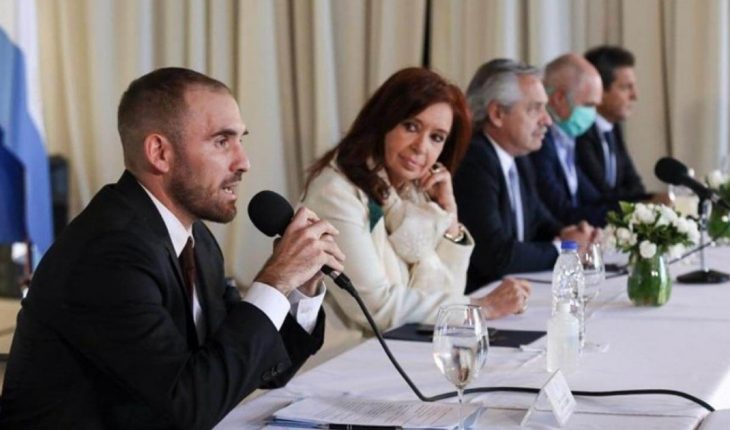It is official: the Government reached an agreement with the main creditors of Argentina’s external debt. This morning, the Ministry of the Economy issued a statement announcing that negotiations with the bonistas who had been working on their resolve came to fruition. This is an understanding with the Ad Hoc Group of Argentine Bonistas, the Argentine Creditors Committee and the Group of Canoes. This includes the world’s largest investment fund, BlackRock.After nearly eight months of intense negotiations, we enter the final stretch of the road to the default exit. The Government submitted an extension of the deadline with the SEC (US Securities And Exchange Commission) until August 24 for as many creditors to enter the exchange. That date, Martín Guzmán will have finished restructuring the debt of $64.8 billion with the private ones.
Debt settlement: What is Guzman’s offer like to exit the default?
The latest offering
This fifth, and final, offer negotiated on Monday is among the (before) last proposal of the national government and the demands of creditors. Guzmán’s fourth offer amounted to securities resulting from the redemption with a Net Present Value (VPN) of $53.5 for each 100-sheet. For its part, BlackRock claimed $56.6 VPN. As it transcended, the deal sits at $54.8 per $100, very close to the $54.9 proposed by the other creditor groups.What is Net Present Value? It is a financial calculation that determines the value of the securities resulting from the redemption. In this case, future bonus payment flows are deducted at the time of default exit. This is an inaccurate concept because it involves a number of variables that do not depend directly on the parties, such as the Argentine Country Risk once their debt is restructured. However, it is the tool that investment funds use to value their assets. For them, VPN is very important: it reflects the value of the titles in their portfolio. The higher VPNs, they can show better performance to their customers. To reach the magic number of $54.8, the Ministry of the Economy says that no increase in payments was used, but changes in the terms and amortization (capital payments) of the new securities. These changes in their structure raised the present value of bonds. The Road
Not long ago, Martín Guzmán’s first offer was contemplating a $39 VPN. Meanwhile, the original proposal of the toughest bondholders, commanded by BlackRock, claimed titles with a present value of $75. To reach the final, future disbursements are estimated to have increased by between $16 billion and $17 billion, starting with the First Proposal by the Minister of Economy. For Guzman’s model, the important thing about the agreement is that the weight of debt interest was reduced, to place them in a range more in line with internationally paid rates. Thus, the average debt coupon was halved: from almost 7% to just over 3% per annum. Although this rate is still far from those in global financial centres (close to 0%), the reduction of coupons means savings in the interest payment of more than $20 billion. The capital-taking, meanwhile, is symbolic: it reaches 1.9% of the total debt. What’s missing
So far the numbers, but the economic section is only one aspect of the restructuring. The other fundamental aspect of the agreement has not yet been defined: the legal one. What will the title reassignment clauses look like? How will the RUFO clause, which guarantees creditors access benefits involving improvements in the redemption offer, be regulated? Will the Collective Action Clauses (CACs) be amended?
Argentina and three creditor groups reached a debt restructuring agreement.https://t.co/zAV8mPE99G — Ministry of Economy of the Nation (@Economia_Ar)
August 4, 2020
The answers to these questions are part of the negotiating table which will run until 24 August. But the future of CACs is particularly important, not only for the Argentine future but for the international financial scheme as a whole. These clauses enable creditors to take legal action against the debtor in the event of non-payment. In the current restructuring, there are two types of CACs: those of the bonds issued in the 2005 exchange, which provide more guarantees to creditors, and the clauses of the bonds issued during the Macri government, more favourable to Argentina. During these months of negotiations, Martín Guzmán showedfirmness to sustain the AGREEd CACs in the 2016- 2017 debt issues. The creditors of the 2005 bonds, meanwhile, always sought to defend their freedoms to start trials against Argentina, such as the one that occurred during 2012 that had as its protagonist the late Judge Griesa. For this reason, whether the “antibuitre” clauses of 2016 are uphold is central to argentina’s future, in terms of avoiding new processes where a small minority of funds make extraordinary profits through litigation against debtor countries. Precedent
The Argentine case will have repercussions around the world, based on its implications for the international financing scheme. Specifically, if the CACs resulting from the exchange are similar to those of 2016, sovereign nations will have more defensive power over “vultures”. In the event of a push-down of the 2005 clauses, almost extinct in the world, it sets a very negative precedent for the issuance of new debt securities in emerging countries, and in the up-and-coming restructurings. This can explain the firmness with which BlackRock and other giants defend the most creditor-friendly CACs. These funds also hold debt securities from Lebanon or Sri Lanka, among other countries that are heading towards their own restructuring process.
This means multiple personalities, academics, and international financial organizations such as the IMF to public their support for Argentina in these negotiations. At stake is the future of the international financial scheme between investment funds and underdeveloped countries. A negative background in our country can be generalized and potentially a destabilization factor for this whole system. What’s coming
Despite the relief it brings to the Argentine authorities to overcome the problem of the default sovereign, the path to Argentina’s economic recovery is just beginning. Structural problems, the crisis deepened by the pandemic and the fall in Argentines’ incomes leave no room for euphoria. In 2021, debt interest payments that condition a transformative process began again, albeit alleviated.
Congratulations to President @alferdez, Minister @Martin_M_Guzman and Argentina’s main creditor groups on reaching an agreement in principle on the country’s debt. A very significant step. Look forward to a successful conclusion in the interest of all. pic.twitter.com/XKaiaQEHZD — Kristalina Georgieva (@KGeorgieva)
August 4, 2020
Martín Guzmán, for his part, will continue in his rally negotiating party once the agreement with the privateers is closed. Follow Kristalina Georgieva and the International Monetary Fund. About the $44 billion that macrism took from the IMF will begin to be discussed immediately. The international body is characterized by not accepting removals in its history and by imposing adjustment programmes to guarantee its payments. Their audits will also condition government policies. One last key question: Is the debt scheme coming out of restructuring sustainable? The Fund’s sustainability analysis, a tool used by Guzmán in trading, set a limit of $50 vpn to consider debt as sustainable. This offer surpasses it. Time, as always, has the final word. In the meantime, we’ll see if the government takes advantage of the financial summer in the middle of winter.
In this note:





